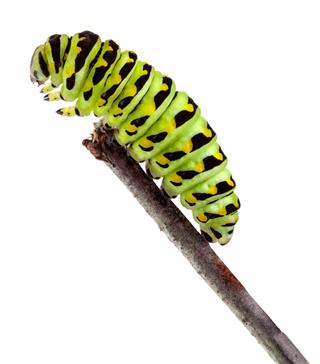
Caterpillars are one of the many creepy crawlies inhabiting in your garden. On first glance they may all seem the same, but identifying caterpillars can be fun as well as difficult. This article presents a basic identification guide of some of the commonly seen caterpillars.
Studying the life stages of a butterfly is very interesting, especially the phase when a caterpillar turns into cocoon, and then, an adult butterfly emerges from it. It is surprising to see a crawly tiny insect grow into something so delicate and beautiful. If you notice butterflies frequently visiting your garden, look further for caterpillars. Most probably, you will see them crawling in the vegetation, or adhering to the plant foliage.
You need to have a keen eye to spot them, as they are experts at camouflage. Here, we have presented the major types of caterpillars and their identification characteristics. With the following information, you will also be able to predict the color and type of butterfly, which will emerge from it.
Note: Some caterpillars, if touched, can cause harm so examining them from a distance is advised.
Identifying Various Caterpillars
For caterpillar identification, you should look out for features like the color (gray, black, brown, green), basic color pattern (striped, spotted, camouflaged), and hair density (thin, sparse, thick). Some of them possess distinctive attributes like a tail, horns, spines, knobs, etc.
Tent Caterpillars
The tent caterpillar, belonging to the Lasiocampidae family, is one of the most devastating pests for garden trees (cherry, plum, apple, peach). It is recognized by the webbed nest or nests in the crotch of branches. Many of them reside in a single nest, which they themselves build with tough layers of silk. Speaking about this hairy caterpillar, they are about 2 inches long, possess hair on their sides, and have a white stripe on their back.
Woolly Bear Caterpillars
If you are interested in fuzzy caterpillars, you can take a look at the caterpillars of the Arctiinae sub-family (Arctiinae was considered a family before). Found in different colors, their whole body is covered with dense hair or setae. Hence, they are known by the name woolly bears. These feed on a wide variety of plants. In fall season, you can find them under rocks, crevices, barks, and other hibernating places.
Slug Caterpillars
They belong to the Limacodidae family which includes caterpillars that look weird. They look like slugs and are found in many different colors and patterns. One commonly visible type is the saddleback (brown moth larvae) which looks like one, with a green and brown body. These hairy moths are basically found in tropical regions, but are found in other regions around the world also. Most species of this group are found in the shades of green.
Prominents
These belong to the Notodontidae family. The caterpillars are mostly hairless (may have spines/humps) and colorful, and the moths are mostly long-winged. Some of them possess the ability to spray acid when threatened. So, beware! They come in many different colors and patterns. One of the different-looking species is a puss moth, which has a deadly face and whip-like tail. Some are observed to be social, while some to be solitary.
Swallowtails
These belong to the Papilionidae family, which include many species. It includes many big and colorful species of butterflies. Their most distinct feature is their forked hind wings. Many of them feed on citrus plants, hence can be considered as pests. But the butterflies are widely appreciated by humans because of their beauty.
So, the next time you see a creepy creature in your garden, don’t blindly call it a caterpillar. Try and examine the characteristics, and check the plant type where you notice the caterpillar. If you have difficulty in identifying them, you can still refer to online images and compare your collected data for correct identification.











